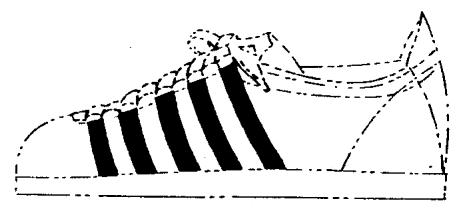General Court: 5-stripes shoe mark lacks distinctive character
The General Court of the European Union decided on 4.12.2015 that a mark consisting of five parallel stripes applied for by K-Swiss lacks distinctive character (case T-3/15).

In 2013 K-Swiss filed with the Office for Harmonisation of the Internal Market (OHIM) an application for protection of the above depicted figurative trademark for goods in Class 25 (athletic shoes). The examiner refused to grant protection for the mark pursuant to Article 7(1)(b) of Regulation No 207/09 (Regulation) due to lack of distinctive character. OHIM’s Board of Appeal as well as the General Court confirmed the examiner’s decision.
OHIM’s Board of Appeal held that in view of its inherently banal character and the fact that it did not depart sufficiently from the widespread practice in the sector of placing a stripe pattern on sports shoes, the mark applied for would not be perceived as an indication of the commercial origin of the goods concerned. Furthermore, it considered that while it is possible that the relevant public’s attention when buying particularly expensive shoes will be heightened, this cannot be presumed without concrete evidence with regard to all goods in that sector. In addition, the evidence provided by K-Swiss did not prove that registering a design consisting of stripes as a trademark for sports shoes corresponds to the usual decision-making practice of OHIM. Finally, the Board stated that the legality of its decisions shall be assessed only on the basis of the Regulation and not on the basis of a previous decision-making practice.
The General Court confirmed Board’s assessment and additionally pointed out that as a rule it is unlikely that through the mere placing of a simple and banal graphic element on the exterior of shoes such element would acquire distinctive character. Further, in the given case the size of the stripes appeared to be determined by the actual shape of the shoes. Notwithstanding the existence of a common practice of placing a sign on the exterior of the shoes as an indication of their commercial origin, in view of the banal nature of the sign at issue, it would be considered in the first place as a decorative element and not as an indication of the origin of the goods at issue. The General Court also considered that in principle simple geometric shapes shall remain accessible to everyone with the exception of such signs which have acquired distinctive character through use.
This judgement joins a wide number of decisions on position marks. It highlights that if an applicant presumes that a position mark has distinctive character, he shall bear a very high burden to prove it and to establish through concrete and well-founded arguments that the mark at issue is inherently distinctive or that it has acquired distinctiveness through use. With regard to the average consumer’s attention, it does not suffice that an applicant only presumes that the consumer will be more attentive to the choice of branded goods in a particular sector, without submitting evidence of such attention related to a particular case. This aspect is of particular relevance for the fashion sector since it comprises goods which vary widely in quality and price.
Well
informed
Subscribe to our newsletter now to stay up to date on the latest developments.
Subscribe now






.jpg?t=a-s&arw=16&arh=9&arm=focuspoint&w=500)